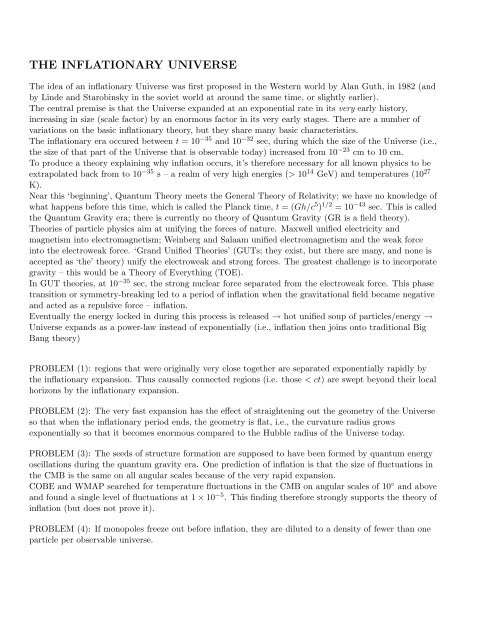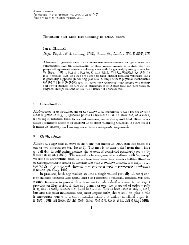Lecture Notes â Cosmology - UCL Astronomy Group
Lecture Notes â Cosmology - UCL Astronomy Group
Lecture Notes â Cosmology - UCL Astronomy Group
Create successful ePaper yourself
Turn your PDF publications into a flip-book with our unique Google optimized e-Paper software.
THE INFLATIONARY UNIVERSE<br />
The idea of an inflationary Universe was first proposed in the Western world by Alan Guth, in 1982 (and<br />
by Linde and Starobinsky in the soviet world at around the same time, or slightly earlier).<br />
The central premise is that the Universe expanded at an exponential rate in its very early history,<br />
increasing in size (scale factor) by an enormous factor in its very early stages. There are a number of<br />
variations on the basic inflationary theory, but they share many basic characteristics.<br />
The inflationary era occured between t = 10 −35 and 10 −32 sec, during which the size of the Universe (i.e.,<br />
the size of that part of the Universe that is observable today) increased from 10 −23 cm to 10 cm.<br />
To produce a theory explaining why inflation occurs, it’s therefore necessary for all known physics to be<br />
extrapolated back from to 10 −35 s – a realm of very high energies (> 10 14 GeV) and temperatures (10 27<br />
K).<br />
Near this ‘beginning’, Quantum Theory meets the General Theory of Relativity; we have no knowledge of<br />
what happens before this time, which is called the Planck time, t = (Gh/c 5 ) 1/2 = 10 −43 sec. This is called<br />
the Quantum Gravity era; there is currently no theory of Quantum Gravity (GR is a field theory).<br />
Theories of particle physics aim at unifying the forces of nature. Maxwell unified electricity and<br />
magnetism into electromagnetism; Weinberg and Salaam unified electromagnetism and the weak force<br />
into the electroweak force. ‘Grand Unified Theories’ (GUTs; they exist, but there are many, and none is<br />
accepted as ‘the’ theory) unify the electroweak and strong forces. The greatest challenge is to incorporate<br />
gravity – this would be a Theory of Everything (TOE).<br />
In GUT theories, at 10 −35 sec, the strong nuclear force separated from the electroweak force. This phase<br />
transition or symmetry-breaking led to a period of inflation when the gravitational field became negative<br />
and acted as a repulsive force – inflation.<br />
Eventually the energy locked in during this process is released → hot unified soup of particles/energy →<br />
Universe expands as a power-law instead of exponentially (i.e., inflation then joins onto traditional Big<br />
Bang theory)<br />
PROBLEM (1): regions that were originally very close together are separated exponentially rapidly by<br />
the inflationary expansion. Thus causally connected regions (i.e. those < ct) are swept beyond their local<br />
horizons by the inflationary expansion.<br />
PROBLEM (2): The very fast expansion has the effect of straightening out the geometry of the Universe<br />
so that when the inflationary period ends, the geometry is flat, i.e., the curvature radius grows<br />
exponentially so that it becomes enormous compared to the Hubble radius of the Universe today.<br />
PROBLEM (3): The seeds of structure formation are supposed to have been formed by quantum energy<br />
oscillations during the quantum gravity era. One prediction of inflation is that the size of fluctuations in<br />
the CMB is the same on all angular scales because of the very rapid expansion.<br />
COBE and WMAP searched for temperature fluctuations in the CMB on angular scales of 10 ◦ and above<br />
and found a single level of fluctuations at 1 × 10 −5 . This finding therefore strongly supports the theory of<br />
inflation (but does not prove it).<br />
PROBLEM (4): If monopoles freeze out before inflation, they are diluted to a density of fewer than one<br />
particle per observable universe.











